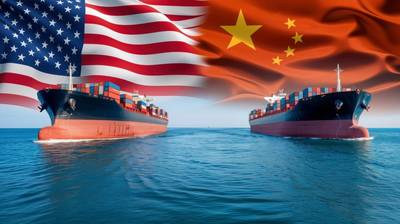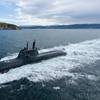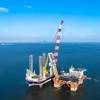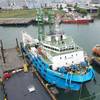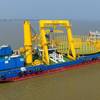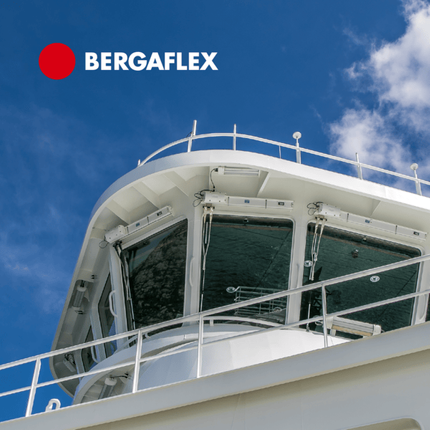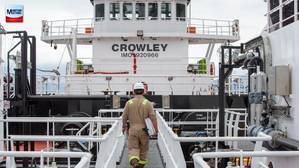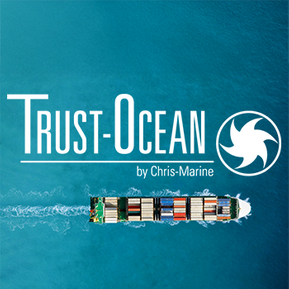Trump Signs Executive Order to Revitalize US Maritime Industry
U.S. President Donald Trump has signed an executive order aimed at ‘restoring American maritime dominance’ through the revival of domestic shipbuilding industry and weakening China’s grasp on the global shipping market.
The Order directs the creation of a Maritime Action Plan (MAP) to revitalize U.S. maritime industries, which will provide a strategy with specific actions to restore and create sustained resiliency for the American maritime industry.
Up until now, government procurement processes and over-regulation have hindered private industry’s ability to build vessels on time and on budget, and according to the current administration, this order reverses that trend.
It instructs the Secretary of Defense to assess options, including the Defense Production Act Title III authorities, to invest in and expand the Maritime Industrial Base.
Such an action will help better utilize and leverage existing authorities to spur public and private investment in the Maritime Industrial Base.
The order directs the United States Trade Representative (USTR) to make recommendations regarding China’s anticompetitive actions within the shipbuilding industry.
It also directs the Secretary of Homeland Security to enforce collection of the Harbor Maintenance Fee and other charges on foreign cargo entering the United States to prevent circumvention via Canada or Mexico.
Trump’s administration considers that this will put an end to a longstanding unfair practice, ensuring all cargoes entering the United States are assessed the proper applicable fees and generating additional revenue for investment into the maritime industry.
“The U.S. government will work with our allies and partners to align trade policies to disrupt China’s non-market practices in the international supply chain and logistics sectors,” the government said.
In addition, the Order establishes a Maritime Security Trust Fund to provide consistent funding for maritime programs in addition to a shipbuilding financial incentives program to boost private investment in U.S. shipbuilding.
It develops Maritime Prosperity Zones to incentivize investment in waterfront communities and is to be modeled on President Trump’s Opportunity Zone concept. Also, it expands Mariner training and education through an investment in the U.S. Merchant Marine Academy and a plan for expanding training opportunities.
To ensure national economic security, the U.S. government will increase the fleet of commercial vessels trading internationally under U.S. flag as well as domestically between our ports.
The MAP will develop a strategy to ensure security and leadership of arctic waterways to address the growing presence of foreign nations in the region and the need for the United States to reestablish itself in the area.
Resurrecting the American Maritime Industry
After being weakened by what the current administration deemed as ‘decades of government neglect’, President Trump is prioritizing the revitalization of the U.S. maritime industry to strengthen the nation’s economic and national security as part of the America First Agenda.
Namely, according to the data provided by the government, 0.2% of the world’s ships are built by the United States, compared to 74% built by China, with 0% of the containers used to move commodities around the world being built by the United States, compared to 96% built by China.
Also, 0% of the ship-to-shore cranes in the United States are built domestically, compared to 80% built by China, with Chinese state-owned software being installed in port operations across the United States, with limited to no alternatives.
During the joint address to Congress, President Trump vowed to “resurrect the American shipbuilding industry, including commercial shipbuilding and military shipbuilding.”
President Trump: “We used to make so many ships. We don’t make them anymore very much, but we’re going to make them very fast, very soon. It will have a huge impact.”
To demonstrate the seriousness with which President Trump views this issue, he also established a new Office of Maritime and Industrial Capacity at the National Security Council in the White House.
Shipbuilders Council of America Welcomes the Move
The Shipbuilders Council of America (SCA), the national association representing the U.S. shipbuilding, maintenance, and repair industry, released the following statement supporting President Trump’s executive order to revitalize the U.S. shipbuilding sector.
“The Shipbuilders Council of America supports President Trump’s action to restore and strengthen America’s shipbuilding and ship repair industry. The establishment of an MPA that includes a Maritime Security Trust Fund, strategic commercial fleet program, along with new tax credits, grants, and strategic investments, will provide a powerful environment to rebuild our shipbuilding capacity and build the fleet of the future.
“A strong US shipyard industry is essential not only for our economic security but also for our homeland and national security.
“With this executive order, it is clear that President Trump and his administration is deeply committed to reenergizing and investing in our nation’s shipyards and we are eager to begin this important work alongside policymakers and industry partners to restore America’s shipbuilding strength for the security and growth of our nation. US shipbuilders stand at the ready,” said Matthew Paxton, President of SCA.
Waterways Operators Voice Support
The American Waterways Operators commended Trump, with President Jennifer Carpenter saying: “As the largest segment of U.S. maritime, the American tugboat, towboat and barge industry stands ready to work with the Trump Administration to further grow and strengthen domestic waterways commerce, address China’s maritime expansionism, and identify opportunities to remove unnecessary regulatory barriers to innovation.”
World Shipping Council Seeks Alternatives to Port Fees
World Shipping Council President & CEO Joe Kramek said: “We want to work constructively with the administration on its efforts to revitalize the U.S. maritime industry.
“As we’ve said previously, revitalizing the U.S. maritime industry will require a comprehensive, realistic and sustained strategy developed by the Administration and Congress and enacted through legislation. The Executive Order outlines several encouraging elements that reflect a serious focus on rebuilding the American maritime industry.
“Given the direction of this Executive Order and the comments made by the U.S. Trade Representative earlier this week, the World Shipping Council is hopeful the USTR recognizes that alternative measures to impose retroactive port fees would disadvantage all aspects of the supply chain - from consumers to farmers, from energy producers to manufacturers,” Kramek said.



